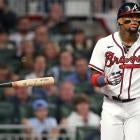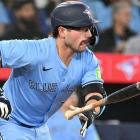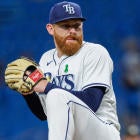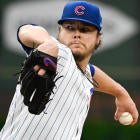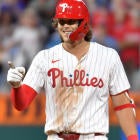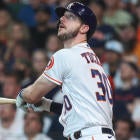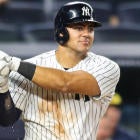Just a month or two ago, as we were all scrambling to find hidden bargains in our drafts and auctions, all the talk was of this year's sleepers.
Like Black Friday shoppers, though, we cause so much commotion looking for a good deal that our secret bargains don't stay secret for long. Back in March, I could call Zack Cozart or J.D. Martinez a sleeper and it would have the ring of truth. Of course, many others discovered the qualities of these players that I liked, and they may have talked them up as well. Now that both are off to good starts and owned in more than 80 percent of the leagues on CBSSports.com, the sleeper label won't stick to either of them.
The shelf life on early spring sleepers often doesn't last far beyond opening day, but that only gives birth to a new crop. The Most Added list on our site is littered with players who have gotten off to fast starts or inherited a more prominent role than what was expected. Most owners are far less excited about players who have slumped early or been delegated to minor roles, but there is a lot more season ahead of us than behind us. The premium placed on the results of the first two weeks provides a new set of market inefficiencies to exploit, as today's slumpers and benchwarmers could be tomorrow's hot waiver commodity.
Particularly overlooked are players who came away from last season with disappointing results. I'm not talking about bounce-back candidates, though, as those were thoroughly discussed during draft season. I'm referring to players whose production was cut short by injury or just a general lack of playing time in 2011. My focus in this column will be on hitters who were highly productive on a per-game basis a year ago, but due to diminished playing time, their year-end stats have left them underappreciated in the early going this season.
Perhaps no one represents the early-season sleeper phenomenon better than Chase Headley. Though he was lacking in the home run department, hitting just four dingers all year, Headley made huge strides in 2011. He became proficient at hitting gap doubles, mashing 28 of them despite playing in just 113 games, and he also walked far more frequently. Despite the lack of home run power, Headley finished with 5.8 Runs Created per 27 Outs (RC/27), placing him just ahead of Alex Rodriguez and David Wright among third basemen. (If you're unfamiliar with the RC/27 metric, see the glossary at the bottom of the page for an explanation.) Because Headley went down with a broken finger that sidelined him for 39 games late in the year, he wound up ranking just 27th at his position in Head-to-Head Fantasy points and 21st in Rotisserie value.
It's not just an injury that has left Headley so underappreciated that he is owned in only 63 percent of the leagues on CBSSports.com, ranking 23rd in ownership rate among third basemen. Last season, he was cruising into the All-Star break, hitting .299 with 25 doubles, but over his next 18 games, Headley slumped to a .258 average with only three doubles. According to CBSSports.com Senior Baseball Writer Scott Miller, Headley was fatigued from playing every day, but because the Padres were lacking bench depth at that point of the season, he played through it. By the time Headley sustained his finger injury, he had trouble just lifting a bat. As a result, Headley's line drive rate plummeted and his BABIP dropped from .380 before the break to .318 during his 18-game slump.
Even with the late summer swoon, Headley finished with a career-best .289 average, .374 on-base percentage and 21.2 percent line drive rate. While he would like to hit more home runs again (and with four taters in his first 13 games, he is off to a good start), it's not a high priority for Headley. As he told MLB.com this offseason, "There are other things (besides home runs), like driving in guys with runners in scoring position and driving in runs with two outs." Headley has used PETCO Park's spacious dimensions to his advantage, hitting line drives and finding the gaps.
With more playing time this year, Headley has the potential for 40-plus doubles, and with sporadic days off, he should be able to maintain a batting average close to .300 and an on-base percentage near .400. Already this year, Headley is walking at an even higher rate, and he is still getting on base at a .414 clip. However, prior to Wednesday's two-homer game at Colorado, the rest of the 27-year-old's stats were underwhelming, making him an ideal buy-low target. Headley is still vastly underowned and now is the time to get him, before other owners start to see his upside.
Headley is not the only Padre to be underowned and underappreciated in Fantasy. We will take a look at a couple of his teammates whose 2011 stats were also comprimised by limited playing time, as well as a handful of other hitters who could be early-season bargains.
Nick Hundley, C, Padres
Ownership rate: 15 percent
Reason
for missed time in 2011: Oblique and elbow injuries resulted in two
separate DL trips.
Why he will surprise: Though it looked like
an aberration, last season's .288 batting average was not entirely a
fluke. Hundley has steadily improved his flyball batting average, which
could be the result of increasing comfort hitting away from PETCO Park.
Believe it or not, Hundley has consistently been a much better hitter at
home, but last year, he finally broke the .250 barrier on the road,
hitting .271. After going hitless in his first seven games this year,
Hundley has already started to settle into a groove, going 7 for 15 over
his last four games.
Jesus Guzman, OF, Padres
Ownership rate: 9 percent
Reason
for missed time in 2011: Guzman was in the minors and then in a
bench role until the Anthony Rizzo
experiment at first base ended shortly after the All-Star break.
Why
he will surprise: Guzman is a line drive hitter who is well-suited
for PETCO Park. He makes consistent contact and rarely hits infield
flies, avoiding easy outs on balls in play. That's why he has been able
to post BABIPs of .342 or higher in each of his last four minor league
stops. Guzman could be out of a job when Carlos Quentin (knee) returns, possibly within the next couple of
weeks, but if he can turn things around soon, don't be surprised if he
winds up cutting into the at-bats of Will Venable,
Chris Denorfia and Yonder Alonso.
Nolan Reimold, OF, Orioles
Ownership rate: 52
percent
Reason for missed time in 2011: Reimold started the
year in the minors but even after a May recall, he was never able to
seize an everyday role in left field.
Why he will surprise:
Maybe it's not accurate to call Reimold a sleeper anymore, since his
ownership rate has doubled in the last week, but he should still be
owned in even more leagues. Reimold's stock dropped two seasons ago when
his power inexplicably evaporated, but last season's numbers -- 13
homers in 267 at-bats with Baltimore -- were in line with his other
major and minor league seasons. Now that Reimold has an everyday job, he
has a chance to hit at least 25 homers and drive in 80 or more runs.
Even though he probably won't hit for a high average, Reimold is still
worth rostering in most mixed leagues.
Wilson Betemit, 3B, Orioles
Ownership rate: 6
percent
Reason for missed time in 2011: Betemit served
primarily in a part-time role with both the Royals and Tigers.
Why
he will surprise: Not only should Betemit see steadier playing time
with the Orioles, but he is a good bet to reverse last season's
disappointing strikeout and walk rates. When Betemit does make contact,
he has proven himself to be a very good hitter on balls in play. He is
not only likely to help with batting average and on-base percentage, but
playing home games at Oriole Park at Camden Yards should boost Betemit's
home run total as well.
Marco Scutaro, 2B, Rockies
Ownership rate: 59
percent
Reason for missed time in 2011: Scutaro went on the DL
with an oblique injury, but even when healthy, he split time at
shortstop for part of the year with Jed Lowrie.
Why
he will surprise: Scutaro has the second base job in Colorado all to
himself, and as a prolific doubles hitter, he can only benefit from
Coors Field's spacious outfield dimensions. He is an excellent contact
hitter -- he has not struck out through his first 10 games -- but he has
yet to notch a flyball base hit. Those will come with time, so now is
your opportunity to grab him in standard mixed leagues. Even now, he
should be starting in far more than 28 percent of our leagues.
Chris Heisey, OF, Reds
Ownership rate: 11 percent
Reason
for missed time in 2011: Heisey was mainly a part-timer, plus he
missed nearly a month with an oblique injury.
Why he will surprise:
Like Reimold, Heisey is a proven power hitter playing in a very good
home run park, but he does not have the benefit of an everyday role. So
far, Ryan Ludwick has received the
majority of the starts in left field, but he is in the midst of a steep
decline and is off to a slow start. Over time, Heisey should grab an
increasingly large share of playing time, making him a viable start in
deeper mixed leagues.
Stay in touch with the most passionate Fantasy staff in the business by following us on Twitter @CBSFantasyBB or Al Melchior at @almelccbs . You can also e-mail us at fantasybaseball@cbsinteractive.com .
|
|
|
xFIP: Also known as Expected Fielding Independent Pitching.
It is an estimate of what a pitcher's ERA would be if it were
based on factors that a pitcher can control, such as strikeouts,
walks and flyballs. xFIP is a derivative of FIP, which was
developed by Tom Tango. Runs Created per 27 Outs (RC/27) -- An estimate of how many runs a lineup would produce per 27 outs if a particular player occupied each spot in the order; ex. the RC/27 for Miguel Cabrera would predict the productivity of a lineup where Cabrera (or his statistical equal) batted in all nine spots; created by Bill James Component ERA (ERC) -- An estimate of a what a pitcher's ERA would be if it were based solely on actual pitching performance; created by Bill James GO/AO -- Ground out-fly out ratio GB/FB -- Ground ball-fly ball ratio Batting Average per Balls in Play (BABIP) -- The percentage of balls in play (at bats minus strikeouts and home runs) that are base hits; research by Voros McCracken and others has established that this rate is largely random and has a norm of approximately 30% Isolated Power -- The difference between slugging percentage and batting average; created by Branch Rickey and Allan Roth Walk Rate -- Walks / (at bats + walks) Whiff Rate -- Strikeouts / at bats |













